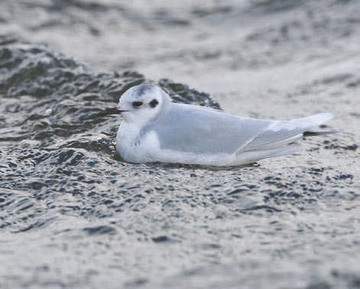Little Gull (Hydrocoloeus minutus)

Little Gull © Richard Steel
The British status of this, the smallest gull in the world, has changed considerably in the last half-century, with the species becoming more common and likely to be found at any season. The turbid water at the mouth of the Mersey has become a favourite feeding area for them to pick invertebrates from the surface, and flocks of several hundred Little Gulls can be present in spring as birds gather on their return to their Baltic breeding grounds. Their rise in numbers from the 1960s is thought to be linked to a substantial increase in the western component of their breeding population in Finland (Hutchinson & Neath 1978), and by the early 1980s the Irish Sea was notable as the main area where winter flocks could be found, although not every year (BTO Winter Atlas).
In the early 20th century, the Little Gull was ‘a rare wanderer to Cheshire in winter’ (Coward 1910) but from about 1950 onwards they could be found in any month of the year, mostly in the two estuaries with more in the Dee than the Mersey (Bell 1962). That would be a reasonable statement of their status to the present day. Winter numbers and occurrences are very variable in both estuaries and birds are not recorded every winter. Most sightings are in January and February and are in single figures, but the county bird reports for the last forty years show monthly maxima in the Mersey of four in November, 20 in December, 37 in January and 60 in February. Unusually, in 1975/ 76 there appeared to be 100 or more birds present for much of the winter and counted occasionally from Hilbre. Away from the coast its occurrences are annual, usually in small numbers, with records widespread across Cheshire in every month over the years since 1967, but mainly from April to September. There have been inland records in the period covered by our Winter Atlas in 13 of the years since 1967, all of single birds.
This winter Atlas map shows their normal distribution, although rather exaggerating the picture by aggregating three years’ data. A maximum of six birds was reported at Hilbre, but the largest flocks were on Hoylake shore in November 2004, when nine birds were in SJ28E and a group of 65 birds in SJ29A. One bird inland, at Sandbach Flashes (SJ75J) in January 2006, is typical for a three-year period.
![]() Little Gulls attempted to breed four times in England, at four different sites and always unsuccessfully, from 1975 to 1987 (Brown & Grice 2005). All four nests were in Black-headed Gull colonies and failed with eggs predated or through human interference. In Cheshire and Wirral there has been no suggestion of breeding but Little Gulls occasionally have visited the gulleries at Woolston, Frodsham Marsh or Inner Marsh Farm. These have nearly always been immature birds but adults in breeding plumage have been seen at Woolston: one or two adults were present from 22 April to 19 May 1985; it was considered possible that an adult remained with a first summer bird from 10 May to 7 June 1988; and two adults were present from 25 to 30 April 2001. During this Atlas period, two adults were present from 15 to 28 April 2006.
Little Gulls attempted to breed four times in England, at four different sites and always unsuccessfully, from 1975 to 1987 (Brown & Grice 2005). All four nests were in Black-headed Gull colonies and failed with eggs predated or through human interference. In Cheshire and Wirral there has been no suggestion of breeding but Little Gulls occasionally have visited the gulleries at Woolston, Frodsham Marsh or Inner Marsh Farm. These have nearly always been immature birds but adults in breeding plumage have been seen at Woolston: one or two adults were present from 22 April to 19 May 1985; it was considered possible that an adult remained with a first summer bird from 10 May to 7 June 1988; and two adults were present from 25 to 30 April 2001. During this Atlas period, two adults were present from 15 to 28 April 2006.
Sponsored by an anonymous CAWOS member

